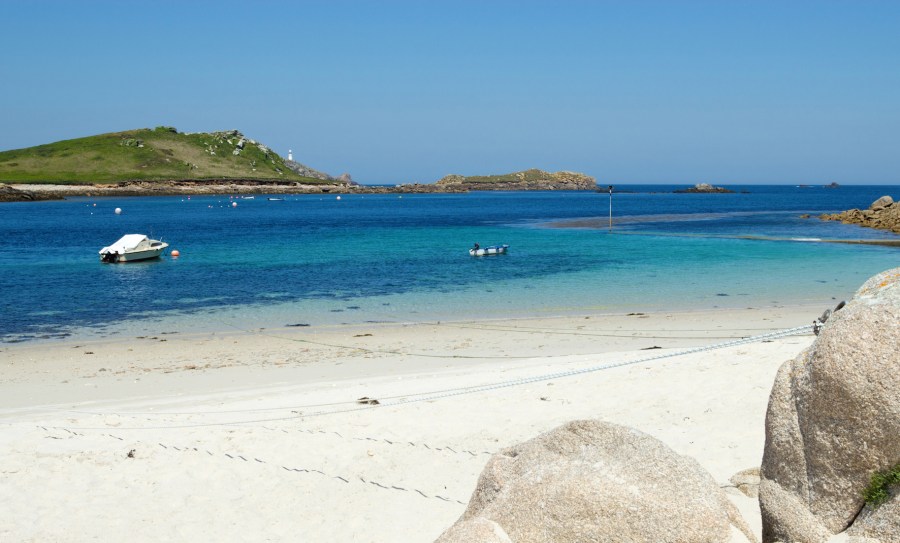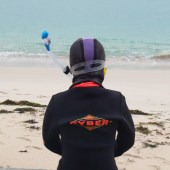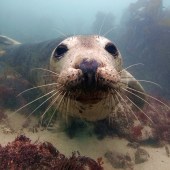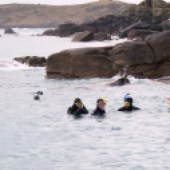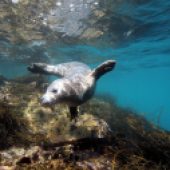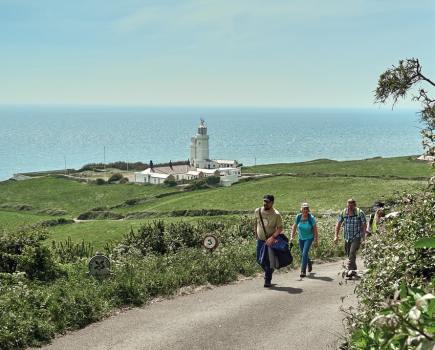Alex Fisher returns to the island of St Martin’s, where she spent many idyllic childhood holidays, for a close encounter with the local seal community.
There is nothing quite like seeing wild animals in their natural environment. A close encounter can be an exhilarating and life-enhancing experience, but many people think they have to travel abroad for anything more than a fleeting glimpse of a dolphin’s tale or a distant flap of a heron’s wings. Not so. If you are prepared to brave the water, you can immerse yourself in the world of the Atlantic grey seal from the small island of St Martin’s, part of the Isles of Scilly, which sit 30 miles off the tip of the Cornish coast.
Anna Cawthray moved to St Martin’s in 1998 and has been running seal snorkelling trips since she arrived. ‘I originally visited the islands to go on a diving holiday with Tim Allsop,’ she says. ‘I fell in love with St Martin’s and when the opportunity arose to work with Tim taking people swimming with seals, I jumped at the opportunity and moved from the mainland.’
Acutely aware of the need to protect the seals and their environment, Anna limits the number of people she takes out on the boats and carefully manages the way people interact with the animals. ‘We are an accredited WiSe Scheme operator, which means we follow appropriate codes of conduct, such as not invading their environment – we drop into the water nearby and let them choose to come to us if they want to. We don’t reach out to touch the animals. Seals are naturally very friendly and curious, so as long as they don’t feel threatened, they will often choose to interact with us if we just sit back and let them.’
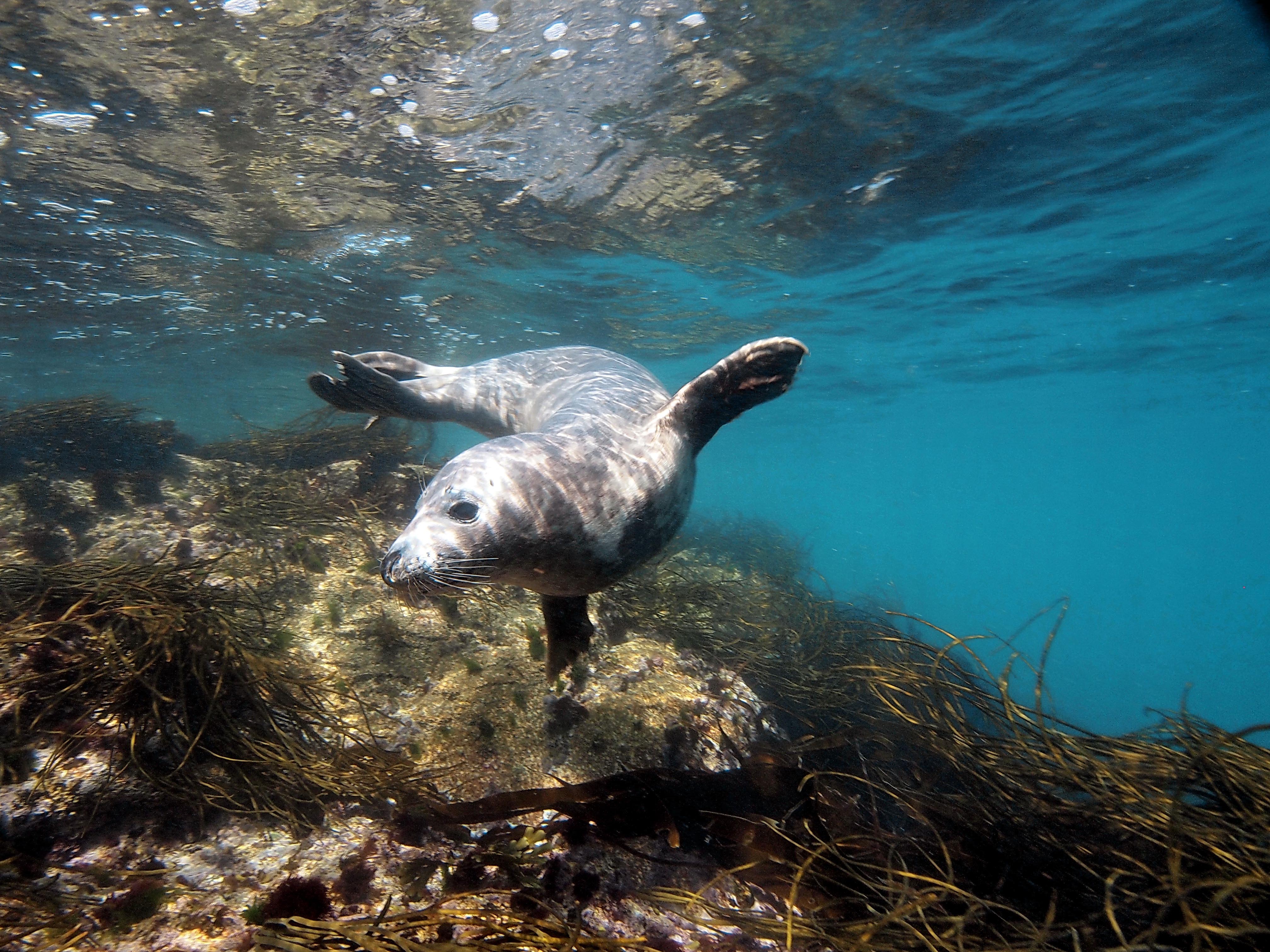
8.45AM THE BOAT TAXI
We are staying on the neighbouring island of Tresco, so we cycle down to the Old Grimsby Quay, where we are being picked up. Boats are more common than cars on this small archipelago and operate like taxis. Tim, who also runs Isles of Scilly Dive School, greets us, and takes us the 15-minute journey across the water to St Martin’s.
It’s March. Dark clouds fill the sky and are reflected in the colour of the sea, which is intermittently splattered with rain. The water looks cold. It has been chilling all winter, and there has been little sunshine to warm it up.
9.15AM SQUEEZING INTO A WINTER WETSUIT
Anna is on the quay waiting to greet us. The clouds have miraculously cleared, the rain has ceased and sun lights up the long expanse of sandy beach that stretches along this side of the island. This is the first time I have visited St Martin’s since I was a child and memories of lobster fishing, shrimping and searching for gold doubloons come flooding back to me like it was yesterday.
Anna leads me to her hut, just a few minutes’ walk across the beach, where she keeps wetsuits and snorkelling gear for the trip. I can understand why she relocated to the island; in the sunshine the sandy beach looks almost tropical and the sea transforms into a brilliant shade of blue. Anna reassures us that her 7mm winter wetsuits will keep us warm and I believe her. However, the first trick is getting into it!
Designed to keep cold water out, it is super-tight and I have to hold my breath to get the zip up. Once I have completed my outfit with boots, gloves and a hood, I walk like a robot, barely able to bend my knees and arms, back down the beach to the boat.
Read next Adventure Holiday in Wales: Sea Kayaking in Pembrokeshire
9.45AM HEADING OUT
We head out to sea and within 10 minutes we can see the seals. Hundreds of them bask on a sandy beach, which, in summer, Anna explains, can be visited by holiday-makers. It’s a spectacular sight.
Anna demonstrates how to blow water out of your snorkel, and runs through the safety rules and guidelines for our swim: ‘Never swim after the animals or try to touch them. They are naturally inquisitive, so just allow them to come up to you.’ She explains that this is the first time she has been out in the water this year, so there is a chance the seals will not be so used to humans and therefore may keep their distance.
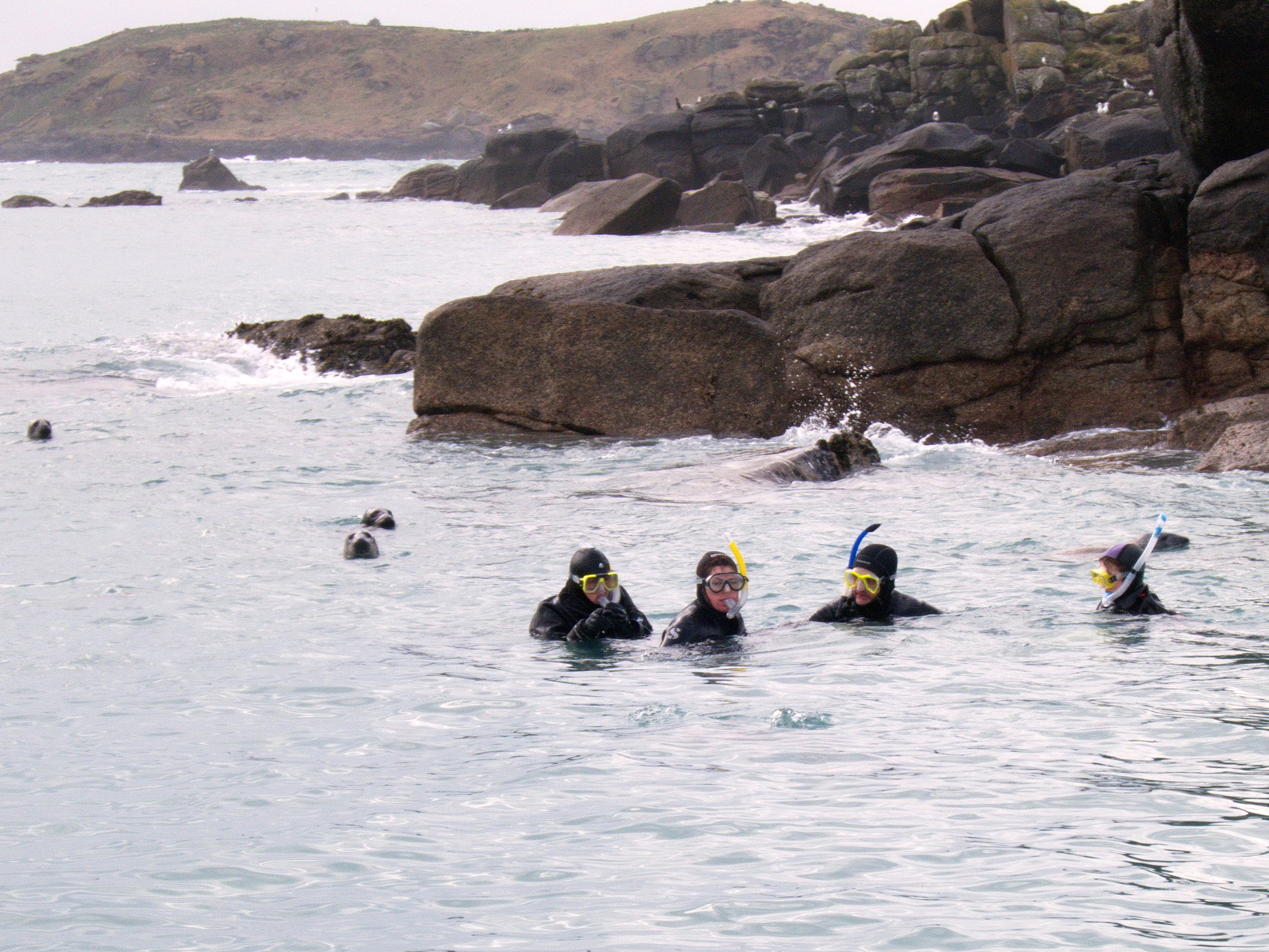
10.30AM THE THRILL OF THE WILD
There are just three of us on this trip, and I am the last to enter the water. My suit keeps me protected from the cold and only my face is exposed. The wetsuit gives me added buoyancy and I take a moment to adjust my balance. I lift my head and notice most of the seals have slipped off their sandy haven and disappeared into the water. Floating, face down, I look though my mask into the deep. A large, dark shape darts below me. Then another. I feel a shudder of excitement. Something brushes my side, but when I turn, it is gone. Bull seals can grow up to around three metres, so these are surprisingly large animals when you get close to them.
Tim stays on the boat, taking photos and keeps an eye on those in the water, in case someone drifts off towards the rocks. I look up to get my bearings and come face to face with a seal just inches from my nose. She looks at me – wide-eyed and puppy-faced. I can see every whisker. Undaunted by my presence, she tilts her head to one side momentarily and maintains her gaze. Then, just as suddenly, she’s gone.
I look around and see heads poking out of the water all around us. Like watery black Labrador puppies, they duck and dive between the snorkellers, swimming by our sides and slapping us gently with their fins, then dashing off. One of them comes so close to our photographer’s face, she seems to plant a kiss on his nose.
Read next Top 12 Coastal Wildlife Experiences
11.30AM FEELING THE COLD
After an hour in the water we start to feel the cold. It is time to get out and, with a little help, we haul ourselves back on to the boat. The small circle of my face that was exposed to the chilly water is numb, and I talk as though I’ve just returned from a visit to the dentist. But we are elated: the thrill of a wild encounter buzzing though our veins.
12 NOON BACK ON DRY LAND
We arrive back at the hut and shiver as we peel off our wetsuits, but I feel so lucky. For me, there is an innate joy that comes hand in hand with immersing myself in the natural world. This is where I feel connected to what life is all about, and it just makes me happy. Opportunities to come in contact with wild animals have dwindled in the past 50 years. Take them when you get the chance!
For more adventure inspiration, click here or pick up a copy of the magazine.
NEED TO KNOW
WHAT IT COSTS
Seal snorkelling trips cost from £49 per person and usually run from March until September. Participants must be a minimum of eight years old, and children must be accompanied by an adult. All seal snorkelling trips must be booked in advance. To book, visit scillysealsnorkelling.com
WHAT TO BRING
Just a towel and your swimming costume or shorts. All snorkelling equipment and wetsuits are provided.
WHERE TO STAY
Coast stayed at Sea Garden Cottages on Tresco. This enclave of contemporary, self-catering cottages sits on the eastern side of the island and offers stunning views out to sea. Guests have access to an indoor pool, sauna and tennis courts. Cottages are available by the night or per week, and prices start from £160 per night for a one-bedroom cottage. Cottages sleep from two to 10 people.
HOW TO GET THERE
It is possible to travel to the islands either by boat or plane with Isles of Scilly Travel.
By boat: The Scillionian III travels from Penzance to St Mary’s in 2½ hours. Fares are from £45 one way.
By air: Take the Skybus from Exeter, Newquay or Land’s End. All flights land on St Mary’s. Returns start at £140 per adult for the 15-minute flight from Land’s End. To book either boat or Skybus, visit islesofscilly-travel.co.uk
For more information about planning a trip to the Isles of Scilly, go to visitislesofscilly.com
ASK THE PRO
Anna Cawthray has a degree in zoology and a BSAC Advanced Instructor certification, which allows her to teach diving and snorkelling. Today, she takes people out snorkelling with seals:
‘I’ve always had a passion for wildlife, as well as diving, so this was my ideal job. I also have my boatman’s licence and first aid at work certificate. There are lots of mundane elements to my work, such as just washing the wetsuits, but it is still the most exciting job I’ve ever done. I love it. Every time I see a seal I still get a flush of excitement. The thrill hasn’t gone. It’s amazing to be out with these creatures on a daily basis. The most important thing is not to chase the seals and not climb on the rocks, but I also tell people to look behind them; the seals always sneak up and you can miss a great encounter if you don’t keep turning around.’
Alex Fisher returns to the island of St Martin’s, where she spent many idyllic childhood holidays, for a close encounter with the local seal community.
There is nothing quite like seeing wild animals in their natural environment. A close encounter can be an exhilarating and life-enhancing experience, but many people think they have to travel abroad for anything more than a fleeting glimpse of a dolphin’s tale or a distant flap of a heron’s wings. Not so. If you are prepared to brave the water, you can immerse yourself in the world of the Atlantic grey seal from the small island of St Martin’s, part of the Isles of Scilly, which sit 30 miles off the tip of the Cornish coast.
Anna Cawthray moved to St Martin’s in 1998 and has been running seal snorkelling trips since she arrived. ‘I originally visited the islands to go on a diving holiday with Tim Allsop,’ she says. ‘I fell in love with St Martin’s and when the opportunity arose to work with Tim taking people swimming with seals, I jumped at the opportunity and moved from the mainland.’
Acutely aware of the need to protect the seals and their environment, Anna limits the number of people she takes out on the boats and carefully manages the way people interact with the animals. ‘We are an accredited WiSe Scheme operator, which means we follow appropriate codes of conduct, such as not invading their environment – we drop into the water nearby and let them choose to come to us if they want to. We don’t reach out to touch the animals. Seals are naturally very friendly and curious, so as long as they don’t feel threatened, they will often choose to interact with us if we just sit back and let them.’

8.45AM THE BOAT TAXI
We are staying on the neighbouring island of Tresco, so we cycle down to the Old Grimsby Quay, where we are being picked up. Boats are more common than cars on this small archipelago and operate like taxis. Tim, who also runs Isles of Scilly Dive School, greets us, and takes us the 15-minute journey across the water to St Martin’s.
It’s March. Dark clouds fill the sky and are reflected in the colour of the sea, which is intermittently splattered with rain. The water looks cold. It has been chilling all winter, and there has been little sunshine to warm it up.
9.15AM SQUEEZING INTO A WINTER WETSUIT
Anna is on the quay waiting to greet us. The clouds have miraculously cleared, the rain has ceased and sun lights up the long expanse of sandy beach that stretches along this side of the island. This is the first time I have visited St Martin’s since I was a child and memories of lobster fishing, shrimping and searching for gold doubloons come flooding back to me like it was yesterday.
Anna leads me to her hut, just a few minutes’ walk across the beach, where she keeps wetsuits and snorkelling gear for the trip. I can understand why she relocated to the island; in the sunshine the sandy beach looks almost tropical and the sea transforms into a brilliant shade of blue. Anna reassures us that her 7mm winter wetsuits will keep us warm and I believe her. However, the first trick is getting into it!
Designed to keep cold water out, it is super-tight and I have to hold my breath to get the zip up. Once I have completed my outfit with boots, gloves and a hood, I walk like a robot, barely able to bend my knees and arms, back down the beach to the boat.
Read next Adventure Holiday in Wales: Sea Kayaking in Pembrokeshire
9.45AM HEADING OUT
We head out to sea and within 10 minutes we can see the seals. Hundreds of them bask on a sandy beach, which, in summer, Anna explains, can be visited by holiday-makers. It’s a spectacular sight.
Anna demonstrates how to blow water out of your snorkel, and runs through the safety rules and guidelines for our swim: ‘Never swim after the animals or try to touch them. They are naturally inquisitive, so just allow them to come up to you.’ She explains that this is the first time she has been out in the water this year, so there is a chance the seals will not be so used to humans and therefore may keep their distance.

10.30AM THE THRILL OF THE WILD
There are just three of us on this trip, and I am the last to enter the water. My suit keeps me protected from the cold and only my face is exposed. The wetsuit gives me added buoyancy and I take a moment to adjust my balance. I lift my head and notice most of the seals have slipped off their sandy haven and disappeared into the water. Floating, face down, I look though my mask into the deep. A large, dark shape darts below me. Then another. I feel a shudder of excitement. Something brushes my side, but when I turn, it is gone. Bull seals can grow up to around three metres, so these are surprisingly large animals when you get close to them.
Tim stays on the boat, taking photos and keeps an eye on those in the water, in case someone drifts off towards the rocks. I look up to get my bearings and come face to face with a seal just inches from my nose. She looks at me – wide-eyed and puppy-faced. I can see every whisker. Undaunted by my presence, she tilts her head to one side momentarily and maintains her gaze. Then, just as suddenly, she’s gone.
I look around and see heads poking out of the water all around us. Like watery black Labrador puppies, they duck and dive between the snorkellers, swimming by our sides and slapping us gently with their fins, then dashing off. One of them comes so close to our photographer’s face, she seems to plant a kiss on his nose.
Read next Top 12 Coastal Wildlife Experiences
11.30AM FEELING THE COLD
After an hour in the water we start to feel the cold. It is time to get out and, with a little help, we haul ourselves back on to the boat. The small circle of my face that was exposed to the chilly water is numb, and I talk as though I’ve just returned from a visit to the dentist. But we are elated: the thrill of a wild encounter buzzing though our veins.
12 NOON BACK ON DRY LAND
We arrive back at the hut and shiver as we peel off our wetsuits, but I feel so lucky. For me, there is an innate joy that comes hand in hand with immersing myself in the natural world. This is where I feel connected to what life is all about, and it just makes me happy. Opportunities to come in contact with wild animals have dwindled in the past 50 years. Take them when you get the chance!
For more adventure inspiration, click here or pick up a copy of the magazine.
NEED TO KNOW
WHAT IT COSTS
Seal snorkelling trips cost from £49 per person and usually run from March until September. Participants must be a minimum of eight years old, and children must be accompanied by an adult. All seal snorkelling trips must be booked in advance. To book, visit scillysealsnorkelling.com
WHAT TO BRING
Just a towel and your swimming costume or shorts. All snorkelling equipment and wetsuits are provided.
WHERE TO STAY
Coast stayed at Sea Garden Cottages on Tresco. This enclave of contemporary, self-catering cottages sits on the eastern side of the island and offers stunning views out to sea. Guests have access to an indoor pool, sauna and tennis courts. Cottages are available by the night or per week, and prices start from £160 per night for a one-bedroom cottage. Cottages sleep from two to 10 people.
HOW TO GET THERE
It is possible to travel to the islands either by boat or plane with Isles of Scilly Travel.
By boat: The Scillionian III travels from Penzance to St Mary’s in 2½ hours. Fares are from £45 one way.
By air: Take the Skybus from Exeter, Newquay or Land’s End. All flights land on St Mary’s. Returns start at £140 per adult for the 15-minute flight from Land’s End. To book either boat or Skybus, visit islesofscilly-travel.co.uk
For more information about planning a trip to the Isles of Scilly, go to visitislesofscilly.com
ASK THE PRO
Anna Cawthray has a degree in zoology and a BSAC Advanced Instructor certification, which allows her to teach diving and snorkelling. Today, she takes people out snorkelling with seals:
‘I’ve always had a passion for wildlife, as well as diving, so this was my ideal job. I also have my boatman’s licence and first aid at work certificate. There are lots of mundane elements to my work, such as just washing the wetsuits, but it is still the most exciting job I’ve ever done. I love it. Every time I see a seal I still get a flush of excitement. The thrill hasn’t gone. It’s amazing to be out with these creatures on a daily basis. The most important thing is not to chase the seals and not climb on the rocks, but I also tell people to look behind them; the seals always sneak up and you can miss a great encounter if you don’t keep turning around.’

